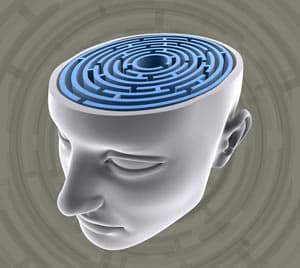Pattern Interrupt – Breaking the Habit
by Erika Slater
Are you a creature of habit, hooked on always doing the same thing over and over, or repeating the same habits even though you know they are detrimental?
Have you ever been told by someone close to you; a family member, spouse, friend, co-worker, a counselor, that if you continue to do things the way you’re currently doing them you’re headed toward more mediocrity, perhaps even disaster?
Albert Einstein said it best when he came up with his famous definition of insanity – doing things the same way over and over, and hoping for, or expecting different results. If you have been engaging in this form of thought process, or acting out the same way, you’d think by now you’d see different results.
Have you?
I’m guessing you haven’t.
Thinking is a habit. In fact it can be either a good habit or a bad habit depending on the outcome. Your feelings and behaviors are also habitual when you think the same way, even if that certain way of thinking is destructive. For example my stop smoking hypnosis programs and weight loss service are all about interrupting patterns of destructive habits.
Furthermore, when you engage in a certain way of thinking, feeling and acting for a period of time, you most likely ‘become‘ that – you’re the end resultant; THINKING + FEELING + ACTING = BECOMING. Most likely, you’re hoping for the ‘BECOMING’ part to be one of success, joy, peace and contentment.

Most people who are ‘habitual thinkers‘ don’t feel the need to change their old or existing way or thinking, or if they do want to change they don’t know how. In fact, many habitual thinkers who foster negative results find deep down they’re addicted to their way of thinking – or are habituated to procrastination promising themselves, or others, they’ll change one day leading them to think, feel and act differently.
The problem is they’ve already ‘become‘ that type of individual who thinks the way they do and they either don’t know how to change things up, or realize they’ll have to invest time and energy into making this change.
When they think about this, change means work and effort, so they put it off and procrastinate to getting around to it ‘someday‘. Unfortunately, like the movie Groundhog Day starring Bill Murray, the days continually repeat and all look and feel the same.
This can be frustrating for those who truly wish and want change!
ARE YOU A PROCRASTINATOR?
What is procrastination?
Procrastination is the act of deliberately avoiding something, or looking for a distraction to get out of anything that seems unpleasant. In fact, you can even procrastinate about thinking – You tell yourself you’ll give it more thought later.
Whatever way you refer to procrastination, you can see that it’s not a positive act, rather one that can be destructive if you’re trying to move ahead in life, or in a different direction.
Procrastination can be very destructive in that it hinders your ability to evolve or change in the positive manner you hope to achieve. You see, procrastination renders people from achieving their goals, dreams and living to a higher standard. The subsequent problem is procrastination becomes habitual (habit forming, even addictive for some) and this eventually becomes a lifestyle for some people.
Did you know you can literally procrastinate about procrastinating? Oh yes! It goes something like this, “I promise I’m going to change for sure this time, like I said many times before, but this time I mean it!” When you break this statement down, you’re merely “talking the talk” but not “walking the walk” because you’re basically stationary – wanting to go in a different direction but stuck in the same place!
Where does procrastination come from in the first place?
Is it an inherited psychological gene for mental laziness that gets passed down from generation to generation, or is more on the nurture side, a learned behavior?
It doesn’t come in the form of a gene of the DNA variety; rather it’s a learned behavior.

One or all three incidences eventually lead to one’s thought processes, and how they choose to act and become. If you will, your present “You” in terms of how you behave, is the sum of experiences from your years past.
Some individuals become habituated or addicted to procrastination and negative thinking patterns as this becomes a “lifestyle” for them.
They use procrastination to avoid anything that they perceive to be potentially unpleasant, hurtful or will result in failure.
In the past they might have experienced an unfortunate event where they made a mistake or failed at something only to receive ridicule, or someone intended for them to feel bad about it.
More experiences like these ones have the potential to render a person helpless in that they begin to perceive anything that involves risk or change, on their part, as having the potential to be emotionally and psychologically damaging. Furthermore, it requires investing time and energy to create change. It becomes hard to change their old ways of thinking as they’ve solidified a ‘pattern‘ which they’re the only ones capable of interrupting in order to create change.
The eventual problem when operating from a mindset of procrastination based on any of these three causes is that when it comes to setting and attaining intentions, the changes you want to see in your life, your mindset reverts back to its old ways based on the past.
Therefore, to overcome the problem of procrastinating and then setting good intentions, you have to cure your mind of what is ailing it – negativity based on irrational past perceptions. If you will, you have to interrupt the old thoughts/perceptions with new stimuli!
OLD PATTERNS DIE HARD!
The problem with procrastination and addictive/habitual thinking is that it’s hard to stop the pattern from continuing unless you actively get involved and this involves becoming more mindful of your thoughts.
The greatest battle many people engage in is with their minds. Too many people believe things are as they are, or always will be at a certain point in their lives or at a certain age – “You can’t teach old dog new tricks.”

It’s all about their perception, or distorted perception. The key element one needs to create is ‘intentions‘, which mean setting a goal, even a goal for change and pursuing that as their endpoint.
Intentions are usually created and put out there based on what you’re telling yourself each day, or moment to moment.
Unfortunately they’re usually ingrained with 2 negative disclaimers, either; 1) Telling yourself what you “don’t” want anymore, and/or 2) Why things ‘never‘ work out, or why you’re ‘not‘ something you want to be.
Your subconscious mind only does what it’s told. It’s your hardware and memory, much like a computer and it cannot discern or challenge what you’re telling it as reality and fantasy. Once you continually use your same thoughts over and over, they become like ‘cookies‘ on your web browser, where you only have to type in the first couple letters and bingo, you’re at the same site.

It therefore goes on autopilot mode and selects what you’ve often selected – the bad habits you’re currently doing based on your habitual thoughts, and those bad habits you “don’t want to do any longer.”
The subconscious mind cannot discern the concept of “not” or “don’t” which are negative concepts, and need to be avoided.
Instead, it zeros in on the primary strength of the concept you’re trying to eradicate from your life – in this example, “smoking.”
So, when you say, “I don’t want to smoke anymore“, your subconscious mind is basically tossing the idea around, “Hmmm, someone say smoke? You want to smoke anymore, you mean some more?”
And if that isn’t discouraging enough, you get the double whammy when you say, “See? Why do I even try, I always start smoking again!”
The subconscious mind always listens and then replies, “Okay then, your wish is my command” and before you know it, you’re doing what you didn’t want to do – which is light up a cigarette!
BREAKING THE PATTERN!
What are you willing to do about your current state?
Do you really want to change it?
The main goal of pattern interrupt is to influence and change your existing thought processes which will alter your strategies or mental state, and thereby your outcomes!

The goal of pattern interrupt is to ‘interrupt‘ the exiting cognitive scripts one has (their thinking pattern) and create surprise, something novel or new which the subconscious mind now affixes itself too.
Most people have a difficult time creating pattern interrupt on their own as their minds are too fixated on their old thought patterns.
With that said, interestingly, many people experience pattern interrupt on a daily basis whenever they’re interrupted by unexpected noises, movements, other people talking, or when they engage in activities that relax or calm them such as working out, going for a long walk, meditating, or even taking a different route to or from work.
It’s all truly about shifting your perspective.
And then there is hypnosis! This has the ability to create successful, lasting effects for creating pattern interrupt.
One of the most difficult activities known to humans is mastering their own thoughts. This is so difficult because it requires monitoring thoughts which requires censoring your moment to moment awareness.
Given we’re creatures of habit; we don’t like to change things, especially when things are already simple. Change requires work and the exertion of energy.
Instead of following through on “resolutions” and intentions you want for a better life, you slip back into old habits because they’re ingrained in your minds and you simply accept them.
Hypnosis is able to get right to the source to correct and create change – it taps into the subconscious mind. This is where successful and lasting changes for pattern interrupt need to occur.
The subconscious is like a sponge and magnet.

And since the mind operates on the law of attraction, whatever thought patterns have been absorbed into the subconscious mind, and accepted as truths will draw more of the same.
Having said this, you want to start recreating your subconscious mind and magnetizing positive thoughts which will be in line with the changes and successes you want to see in your life.
Through using hypnosis, you can have thought processes that have been there forever reprogrammed with post-hypnotic suggestions that have you focusing on the thoughts you most want to experience.
It’s all about replacing the old thoughts with new thoughts.
You can do this on your own, but it’ll require monitoring your destructive, procrastinating thoughts as you think them, catching yourself doing it, and immediately deleting them, and replacing them with new positive ones. This is hard – even getting your head around this level of self-awareness can be daunting for most folks.
Another, and better way, is using hypnotherapy.
Hypnosis will help you achieve the same result, but you won’t have to do monitoring consciously, as it puts your subconscious mind to work to replace the old with new.
Using hypnosis is my preferred form of pattern interrupt as it not only interrupts faulty thought patterns, but let’s you totally re-create positive new ones! And this is the primary outcome of pattern interrupts and makes all the difference between remaining “stuck in the rut” and breaking free for new and exciting outcomes. If you want to consider working directly with me through my online or in-office sessions then check out my Hypnosis Services or if you’ve a specific need around pattern interrupts then contact me here.
ADDITIONAL RESOURCES RELATED TO PATTERN INTERRUPT:
Guide to “What is Hypnosis” here >>>
Library of Self-Hypnosis Downloads Products >>>
Erika Slater CH
Director
Free At Last Hypnosis
CATEGORIES
FEATURED POSTS
Interested in making a significant change in your life and interested in learning more about what I do and how I do it? Discover my hypnotherapy services here or contact me here.

DISCOVER HOW TO START CHANGING HABITS TODAY.
In this free audio hypnosis session, you’ll experience the power of your subconscious mind to begin to change your habits. If you've never experienced hypnosis before then this is a great introduction...


